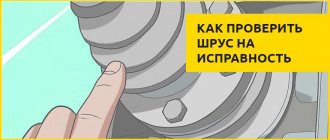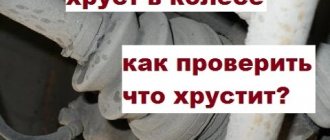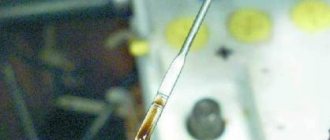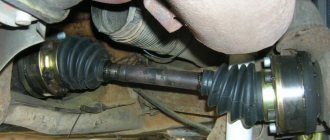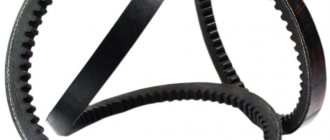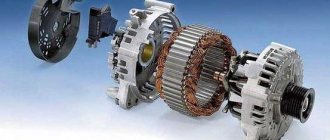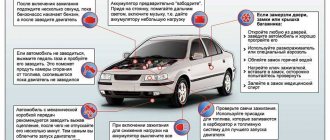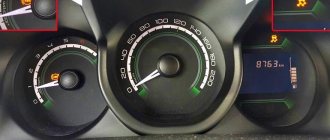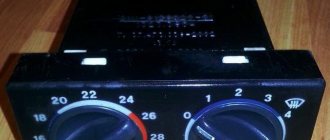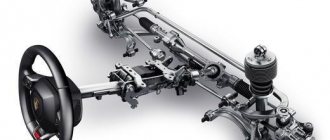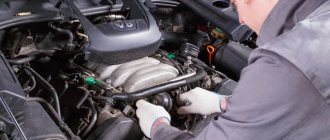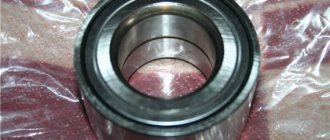In the article:
- What is a constant velocity joint used for?
- Types of CV joints and their design features
- Causes of crunching in CV joints
- Why does the hinge crunch at low temperatures?
- What happens if you ignore the problem?
- Identifying a specific faulty joint
- Determining a faulty outer CV joint
- Determining a faulty inner CV joint
- Another method suitable for both types of CV joints
- Solution
In the front suspension of a front-wheel drive car there is a part with a strange name, at first glance, CV joint. And not just one, but four. The tricky name means “constant velocity joint.” In the technical literature, the term homokinetic hinge is usually used. Externally, the CV joint resembles a grenade, which is why people call it that. But for most car enthusiasts, neither the shape nor the decoding of the abbreviation explains what this part is intended for. Let's try to figure this out, and at the same time find out how a CV joint malfunction manifests itself and how to determine which joint is the source of the problem.
A clear creaking sound when turning the steering wheel - checking for possible problems
If noise is made when driving, then it makes sense to contact a car service.
Before doing this, you need to clarify what is happening. To do this, you need to answer the following questions:
- It is necessary to more specifically determine what kind of noise is heard. To be clear, this refers to a squeaking, grinding, knocking or other sound.
- It is necessary to clarify the circumstances under which this occurs. Some possible answers to this question: while moving, while stopping, or in another case.
- How constantly does the noise occur and when: with any movement or only in some specific circumstances.
- It is necessary to find out whether the creaking occurs in the same way when turning in both directions or only occurs in one direction.
Various features of why the wheels squeak when turning and the malfunction that has occurred will enable car service specialists to repair the car.
Shock absorber spring burst
When you hear a creaking or crunching sound in the wheel area, it is necessary to determine its source and carry out repairs. In some cases, if you do not pay attention to the problem that has arisen, it will cause serious damage.
What is a constant velocity joint used for?
The main feature of front-wheel drive is that rotation has to be transmitted to the wheels, which not only move up and down while driving, but also turn at a significant angle.
In a cardan transmission, which was initially used for this purpose, deviation from the coaxial arrangement of the shafts leads to a decrease in the angular speed of rotation of the driven shaft relative to the driving one. And the sharper the turn the car makes, the slower the rotation of the driven axles. As a result, all this resulted in loss of power, jerking in corners and intense operation of the transmission as a whole, which means rapid wear and reduction in the service life of its parts. Cardan joints themselves also did not have longevity.
The invention of the constant velocity joint radically changed the situation. Its use allows the axle shafts to rotate at a constant angular speed, even if the wheels are turned at a significant angle. As a result, the absence of vibrations and jerks is ensured, and most importantly, the transmission of rotation from the motor to the wheels is carried out without significant losses of power.
Do-it-yourself replacement or professional help
So, knowing how to check the CV joint and being sure that it is the one that is faulty, the car enthusiast has a question about how to fix the breakdown. It is irrational to repair CV joints; such parts must be replaced. If you have a convenient garage and all the necessary tools, you can carry out the repairs yourself.
If you have doubts about your own abilities, or do not have an experienced mentor or the necessary tools, then it is better to seek help from a car service center. Otherwise, there is a risk of incorrect installation and damaging the new part.
Types of CV joints and their design features
There are two CV joints on each of the axle shafts. That is, in a front-wheel drive car there are only four grenades - two internal and two external.
Internal and external hinges differ functionally and structurally. The internal one is located near the gearbox and is designed to transmit torque from the differential to the axle shaft. Its working angle, as a rule, does not exceed 20°, but at the same time it allows some displacement along the axis, thus providing the possibility of changing its length. Shortening or lengthening the drive shaft is necessary to compensate for suspension travel.
The outer CV joint is mounted on the opposite end of the axle shaft, next to the wheel. It is capable of operating at an angle of about 40°, providing rotation and rotation of the wheel. It is clear that the external grenade works under more intense conditions, and therefore fails somewhat more often than the internal one. Dirt flying from under the wheels also contributes to this; the outer CV joint obviously gets more of it than the inner one.
There are a number of design varieties of constant velocity joints. However, nowadays in passenger vehicles you can find mainly two types of CV joints - “Tripod” and Rzeppa ball joint. The first one does not have a large working angle, but it is reliable and relatively cheap, and therefore it is usually used as an internal hinge. It uses rollers that are placed on a three-beam fork and rotate on needle bearings.
The second has a much larger working angle, so it is logical that it is used as an external CV joint. It is named after the mechanical engineer Alfred Zeppa (also commonly mispronounced Rzeppa), a native of Poland who worked for Ford. It was he who, in 1926, created the design of a constant velocity joint with six balls, which are held in the holes of a separator located between the body and the inner race. The movement of the balls along the grooves on the inner race and from the inside of the housing makes it possible to change the angle between the axes of the drive and driven shaft within a wide range.
Zheppa's CV joint and its modernized varieties (Birfield, Lebro, GKN and others) are still successfully used in the automotive industry.
Causes of crunching in CV joints
The constant velocity joints themselves are very reliable and can easily last for a couple of hundred thousand kilometers, or even longer. If, of course, you don’t allow dirt and water to get into them, change boots and lubricant on time, drive carefully and avoid bad roads.
And yet grenades also fail sooner or later. For one reason or another, grooves appear in the holder or joint body. The balls rolling inside hit them, producing a characteristic dull metallic knock. Then they talk about the “crunch” of the CV joint.
Play and wear occur due to natural wear and tear or as a result of improper operation. There may be several reasons, but the most common is a damaged boot. Through ruptures in the protective rubber boot, oil flies out, leaving the rubbing elements of the hinge without lubrication. In addition, through the cracks of the boot, moisture, debris, and sand enter the CV joint, which act as an abrasive, accelerating the wear of the grenade. The condition of the anthers should be checked regularly - every 5...6 thousand kilometers, and at the slightest sign of damage, change them without hesitation. A rubber boot costs much less than a CV joint.
The second most common factor leading to premature wear of grenades is an aggressive driving style. Extreme driving over rough terrain and a sudden start of movement when the wheels are turned out are especially destructive for CV joints.
Another possible reason is engine tuning with increased power. It can significantly increase the load on the transmission. As a result, its elements, including CV joints, will be subject to faster wear.
If the grenade begins to knock a short time after replacement, you may have come across a defective copy or a fake. But it is also impossible to exclude installation errors that could damage a new high-quality hinge. Therefore, if you are not very confident in your abilities, it is better to entrust the replacement of CV joints to specialists.
Common causes of knocking noise associated with the steering mechanism
Now let's look at typical problems and how to fix them.
The first thing you need to do is check the pressure in the wheels, because the difference in tire inflation may be the cause of the knocking.
Then check the fastening of the plastic protective fender liners. It is quite possible that the screws that secure them to the body have broken out, causing the fender liner to come off and cling to the wheel, making a knocking sound when turning.
POPULAR WITH READERS: ZIL-157, spare parts catalog
In general, such a malfunction is very easy to fix; all you need to do is secure the torn fender liner with new screws.
The most dangerous from a safety point of view is the appearance of a knock in the steering mechanism itself. To check the condition of the mechanism, you will need to drive the car onto an overpass.
The first thing you need to check is the steering ends. Damage to the tip boot leads to sand getting inside it, which intensively wears out the surfaces of this element, causing play to appear in the tip, which is the source of knocking.
You can check the condition of the ends by loosening the tie rod with a pry bar.
Strong play and knocking will indicate wear on the tip and the need to replace it.
Steering ends for domestic cars are relatively inexpensive, and you can purchase them at almost any auto store.
Replacing them is also easy. It is recommended to replace both tips at once.
The complexity of performing this work comes down to the need to use a special puller.
After replacing the tips, you will still have to contact a service station to set the wheel alignment angles.
A knock may also appear in the steering rod silent blocks. They are located in the place where these rods are attached to the steering rack.
Delamination of the rubber of these silent blocks can also lead to knocking, although it will appear not only when turning, but constantly while driving.
This steering mechanism malfunction, although very rare, is still possible. It can be eliminated by removing the steering rods and pressing in new silent blocks.
A knock may also appear in the steering mechanism itself. It usually forms after the rack guide bushings wear out, causing a gap to appear between the rack and gear.
In some cases, everything can be eliminated by removing the gap with the mechanism's adjusting bolt.
If this is no longer possible, you will need to remove the mechanism from the car, disassemble it and replace the worn guide bushings.
A knock may even appear in the steering column universal joint.
If for some reason it is damaged, it is quite possible that it is the cause of the appearance of third-party sounds. This problem is “treated” by replacing the cardan.
You should also check the fastening of the mechanism body to the car body. Loose clamps may cause noise. This can all be eliminated by tightening the fastening nuts.
Why does the hinge crunch at low temperatures?
Lubrication is of particular importance in ensuring long-term proper operation of the CV joint. Its condition needs to be monitored and changed periodically. But you can’t fill a grenade with the first lubricant you come across. The use of graphite lubricant is strictly prohibited. Special oil is produced for CV joints, usually containing molybdenum disulfide as an additive. It has water-repellent properties and can soften shock loads. This is what should be used. To properly replace the lubricant, the grenade must be removed, disassembled and thoroughly washed.
The quality of the lubricant is not always at the proper level. Some varieties do not tolerate frost well and may thicken at low temperatures. Then the pomegranates begin to crunch. Internal CV joints warm up quite quickly and stop knocking, while external CV joints can continue to make noise much longer. In such cases, it is better to avoid sharp turns and acceleration until the crunching stops. It is probably necessary to select a higher quality lubricant that can ensure normal operation of the hinges in frosty weather.
What happens if you ignore the problem?
Constant velocity joints do not fall apart overnight without any preliminary symptoms. Internal defects and wear-outs appear gradually, and the process of destruction of the part takes quite a long time. Therefore, you can drive with crisp joints for some time, but you should, if possible, avoid sudden acceleration and turns at high speed. It is also important not to miss the moment and not allow the grenade to collapse. It is possible that other transmission parts will also be damaged. With a collapsed CV joint, the car will not be able to move, and you will have to deliver it to the garage or service station using a tug or tow truck. In some cases, a jammed CV joint can lead to loss of vehicle control. There is hardly any need to explain what consequences this may cause.
Therefore, if there is a knocking or crunching sound in the suspension, do not put off finding out the reasons and determining the culprit of the problem. Moreover, sometimes a crunching noise simply means a lack of lubrication, and such a malfunction can be fixed relatively simply and cheaply.
Causes of creaking rack and steering column
If the steering column is not working properly, you will hear a slight knock and noticeable vibration when driving. The cause of this malfunction is a strong mechanical impact on the steering wheel, during sudden braking or a collision during an accident. Such signs indicate deformation of the steering column. Also, strange sounds may come from the coupling.
Of course, the best way to eliminate a squeaking or knocking sound when moving and turning the steering column is to simply replace the non-functioning element with a new part. Unfortunately, the steering column is expensive, which means you need to look for ways to repair the old part. Vibration and noise can be eliminated using lubricant. Lubricating the driveshaft with a small amount of grease can eliminate unwanted noise, but this will only mask the symptoms.
It is important to seek help from professionals who can fix the broken part before it completely fails.
Identifying a specific faulty joint
Since a front-wheel drive vehicle has four CV joints, it is important to isolate the problem and determine which one requires replacement or, at a minimum, lubrication. Many people do not know how to do this, although in many cases everything turns out to be not so difficult.
First of all, of course, you should do a visual inspection. If the boot is damaged, then the CV joint definitely requires, at a minimum, dismantling, maintenance, lubrication and replacement of the protective rubber boot, and at maximum, replacement. Damage to the boot will be indirectly indicated by grease splashed on adjacent parts.
Try turning the hinge around the axis by hand. A serviceable CV joint should remain stationary. If there is play, then the hinge definitely needs to be replaced. However, it will be more reliable to determine the presence or absence of play by dismantling the axle shaft with grenades and holding it in a vice.
Determining a faulty outer CV joint
The greater the angle between the drive and driven shafts, the greater the load the joint experiences, especially if it receives significant torque from the motor. Hence the easiest way to determine a faulty outer CV joint. Turn the steering wheel as far as possible to the left or right and suddenly start moving. If the crunching noise occurs when the wheels are turned to the left, then the problem is in the left outer grenade. If the knocking starts when the steering wheel is turned to the right, you need to deal with the right outer joint. The sound, as a rule, is heard quite clearly and may be accompanied by vibration on the steering wheel. The symptoms are usually quite pronounced and do not raise doubts. If the sound is weak, especially on the right side, then it is better to ask an assistant to listen.
Determining a faulty inner CV joint
A faulty internal CV joint often does not manifest itself in such an obvious way. If the road surface is smooth, the problematic internal grenade will usually begin to make sounds at high speeds or during acceleration, when the load on the joint increases. Vibration and jerking of the machine are also possible here. At low to medium speeds, the inner joint's crunching noise can be heard when driving in a straight line on uneven roads, especially when the tire hits a pothole.
You can choose a suitable pothole, fortunately, there is a very wide choice of them on domestic roads, and try to drive through it first only with the left wheel, then only with the right. If a metallic crunch occurs in the first case, then the left inner CV joint is suspect, if in the second case, check the right one. Just don’t overdo it, otherwise you can ruin a working grenade in this way.
And don’t forget that similar knocking noises when driving on a bad road can also come from suspension parts.
Another method suitable for both types of CV joints
If you have a jack on hand, you can check all four joints and determine with greater accuracy which one is causing the problem. The procedure is:
1. Set the steering wheel to the middle position.
2. Suspend one of the front wheels.
3. Engage the handbrake, place the gear shift lever in neutral and start the engine.
4. Having depressed the clutch, engage 1st gear and gradually release the clutch pedal. The hanging wheel will begin to spin.
5. Apply load to the CV joints by gently applying the brakes. A problematic internal hinge will make itself felt with a characteristic crunch. If both internal grenades are working properly, then there will be no extraneous sounds, and the engine will begin to stall.
6. Now turn the steering wheel as far as possible to the left. A faulty inner joint will still make noise. If the left outer grenade has internal workings, it will also rattle. Accordingly, the sound will become louder.
7. Check the right outer CV joint in the same way, turning the steering wheel all the way to the right.
After completing the check, set the gearshift knob to neutral, stop the engine and wait until the wheel stops rotating. Now you can lower the car to the ground.
How to determine the cause of squeaking and grinding noises when turning the steering wheel
It is important that extraneous noise while the car is moving can appear at any speed. The driver, turning the steering wheel in one direction or another, hears an uncharacteristic grinding sound even when driving at a speed of 30 km/h
It is noteworthy that when turning the steering wheel, a grinding noise can be heard even when the car is standing still.
Modern car models are equipped with power steering (power steering), thanks to which the steering wheel rotates as easily and silently as possible. For basic configurations, a slight hum or hissing sounds are allowed when the steering wheel is turned to extreme positions. However, there should be no grinding or squeaking noise regardless of whether power steering is installed or not.
Determining the cause of uncharacteristic noises when turning the steering wheel is not easy. The first step is to establish not only the source of uncharacteristic sounds, but also additional symptoms. Indeed, in a number of cases, the driver not only hears unusual sounds, but also feels any problems with the controls.
When diagnosing the cause of noise, several important factors must be taken into account:
- specificity of noise (humming, creaking, grinding, crunching, knocking);
- moments when noise appears (grinding noise when turning the steering wheel while moving or while the car is parked);
- frequency of noise - depending on weather conditions, engine temperature, vehicle load and other factors;
- the appearance of a grinding noise when turning the steering wheel left or right, or in both directions;
- What other symptoms appear along with the noise?
Complete answers to these questions will help a car service specialist determine the source of the problem as accurately as possible and eliminate it.
Solution
Having identified a problematic hinge, you need to dismantle it, disassemble it, thoroughly wash it and inspect it. If there are wearouts, damage, or play, the CV joint should be replaced with a new one. There is no point in repairing it. Attempting to sand work surfaces will most likely be a waste of time and effort and will not provide long-term results.
If the part is in order, after washing it should be filled with special lubricant for CV joints and returned to its place. The same should be done with the new hinge. As a rule, for an internal grenade you need about 100... 120 g of lubricant, for an external one - a little less. During assembly, lubricant must also be placed under the boot, and then securely tighten it with clamps on both sides.
Since errors during installation of CV joints can lead to their premature failure, it is better to carry out this procedure for the first time in the presence of a more experienced car enthusiast, who will explain all the intricacies of the process along the way.
When replacing parts that have a symmetrical pair in a machine, you should follow the general rule - change both elements at the same time. This rule should also be applied to CV joints, but with one important clarification: never remove both axle shafts at once to prevent the differential gears from shifting. First, work with one axle shaft and install it in place, only then you can dismantle the second one if necessary.
Cheap hinges, produced under little-known brands, are often made of low-quality metal and are not very carefully assembled; there are also initially defective parts. Such products should be avoided. You should also be careful when choosing where to buy. In the Chinese online store you can purchase the necessary spare parts for transmissions, suspensions and other systems of cars made in China and Europe.
Obvious creaking when turning the steering wheel - checking for possible problems
What to do and how to fix squeaking and grinding noises when turning the steering wheel
Any extraneous sounds in the main mechanisms of the car should alert the owner and become a reason to contact specialists. But many drivers prefer to find problems on their own. This is a sensible decision, because service stations do not always approach diagnostics objectively, but you should check the problems of your car only if you have a minimal understanding of the design of the vehicle. If your car has a squeaking sound when you turn the steering wheel, this may mean that some steering or suspension components have failed.
You can check all the problems yourself or with one assistant, but it is better to diagnose the breakdown at a professional service station. The diagnostic rules in this case do not establish the order of testing and other subtleties, but the correct execution of each individual test is extremely important for a good result.
Checking the steering rack and column - the most common causes of squeaking
The most popular causes of squeaking when turning the steering wheel are breakdowns in the steering rack system, as well as the steering column. Let's look at these nodes one by one. The steering column is a fairly simple mechanism that breaks down extremely rarely, but when it does break down it often requires a complex and expensive replacement. Therefore, if it breaks down, you cannot do without professional service.
If the steering column is the culprit of the problem, the squeak will be superficial, it can be felt directly on the steering wheel and often gives off vibrations. Often in this case the problem is quite easy to determine. The cause of the breakdown may be a sharp impact on the steering wheel, for example, during braking or a minor accident. The column may simply become bent. With the steering rack everything is much more complicated; there can be many problems:
- the inside of the rack is worn out, the creaking is present due to poor contact of the mechanism with the body;
- the anthers on the rack have torn and dirt has gotten inside - this can be easily checked by feeling the rubber anthers on the rack body with your hand;
- the rack mechanism weakened and began to creak when passing through the body;
- creaking can also be caused by steering tips, which rub against the rods when turning;
- The rack was damaged, its body was slightly bent and began to make squeaks when turning the steering wheel.
These are just assumptions and not the exact causes of the problems. In most cases, if the steering rack is severely worn or bent, there is no point in repairing it. The mechanism is changed as a whole, which can cost a considerable amount of money. However, this unit is responsible for high-quality control and safety during the trip, therefore its quality is the main goal of repair.
There is no point in delaying the repair of the steering rack or column. These control system components are important because they constantly take part in driving the car. It is enough to trigger a problem to allow incredible play in the steering wheel or too much force to turn. This is an unacceptable discomfort that affects driver safety and confidence.
Other causes of squeaking steering
When diagnosing, you should not stop only at the steering rack and column. It is also necessary to check the tips and rods, especially the places where they are attached. Often the steering rods are slightly unscrewed, causing play to form at the place where they are attached, which leads to constant squeaks and a real danger of losing control of the car right on the road.
It is necessary to diagnose such problems as quickly as possible, otherwise the consequences will be unpleasant. Always remember that the cost of repairs if a problem is quickly detected in the bud turns out to be ridiculous, but restoration or a comprehensive replacement of entire car components will be very expensive. When creaking, you need to check the following nodes:
- the tips of the steering rack, which take all the effort when turning the steering wheel;
- steering rods connecting the rack to the wheel drives and performing direct rotation;
- car suspension elements that are responsible for turning the wheels and their normal rotation during turns;
- brake system - it can also be the culprit of the squeak if the sound appears only when moving;
- the steering wheel itself - a squeak may appear when rubbing against the plastic or in the signal mechanism.
